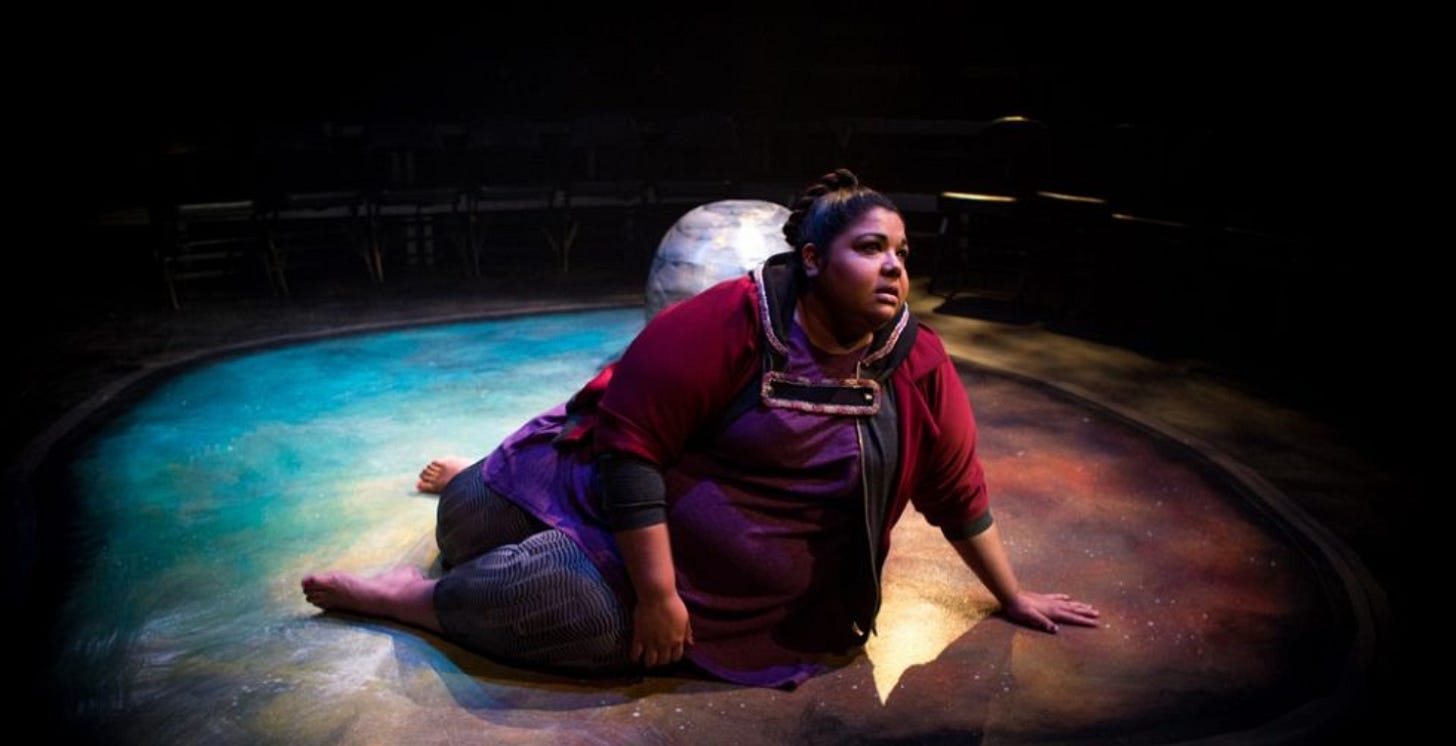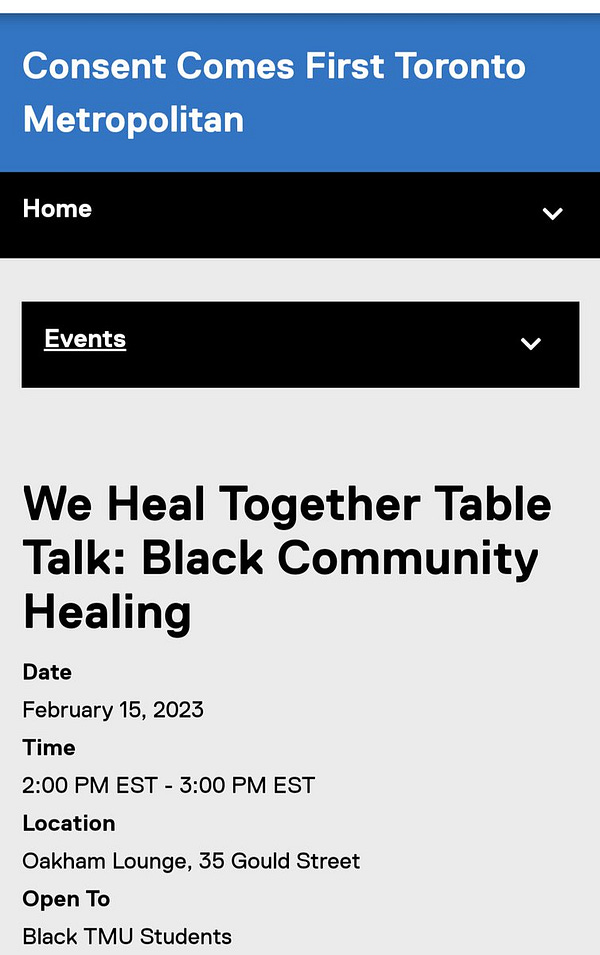Note: Some Substack readers have been trying to send me money. This is appreciated. But to be clear, this is not a pay-to-read Substack. It’s my hobby site. (If you are intent on supporting my work in a tangible way, please consider becoming a subscriber at Quillette.) And all of the articles I publish on Deeply Problematic are completely free to read in their entirety. So save your money, or (even better) donate it to Substackers who rely on their Substack income to pay the bills. In that regard, here are some of my recommendations.
A few months ago, I was playing disc golf with one of my Toronto friends—let’s call him Pete—a perfectly decent guy whose politics happen to lie considerably to the left of my own. He’s a vegetarian (which I admire), a fervent environmentalist (also fine), and an occasional Green Party campaign volunteer (ok, whatever). Like a lot of leftists, he puts up with me because I give him an opportunity to vent about the truths he’s not allowed to talk about when he’s with his fellow bien pensants.
During this particular round of disc golf, our discussion turned to the performing arts. I had started things off by talking about my Mirvish subscription. Mirvish is the big, mainstream theatre production company in Toronto. And it puts on expensive, Broadway-style, crowd-pleasing plays and musicals at four of the city’s biggest theaters. You’re not going to find a lot of wokery or tedious theory-driven stage experiments at Mirvish shows. Refreshingly (for Canada), these are performances that audiences actually want to see, and which (get this!) turn a profit without a ton of government subsidies.
On the other hand, I complained (my kvetching relationship with Pete goes both ways) that a lot of Mirvish shows are somewhat, well, banal for my tastes. One recent musical called Fisherman’s Friends, for instance, consisted in large part of a group of very goyish middle aged men reciting Cornish sea shanties in a stage version of a coastal English pub. It was fine, I guess. As was The Shark is Broken (though my wife fell asleep), and Harry Potter and the Cursed Child (which had insanely good special effects, but dear lord the pop-psychology dialogue in the last 15 minutes was a hot maudlin mess). And so I asked Pete if he might be able to recommend some of the more intellectually challenging theatrical fare that he’d seen at one of those black-turtleneck venues he likes to frequent.
Alas, he could not—which is what brought us to his turn for complaints. Pete told me that he’d given up on his own go-to Toronto theatre—a pay-what-you-can outfit called Theatre Passe Muraille, whose mission is to champion a more “diverse representation of artists, audience members and stories,” as well as more ”collaborative and inclusive theatre practices.” The fare at Passe Muraille had always had an activist element, Pete said. But many of the new productions were going even further in this regard, and had become (by his account) simply unwatchable.
One forthcoming production, trace, is marketed as “a sound-based, interdisciplinary performance piece that focuses on the ongoing nature of queer being and becoming.” (“Original compositions made from archival recordings of [Tristan R.] Whiston’s singing and speaking voice at different stages of his gender transition are mixed live into a multi-track soundscape to create an immersive and interactive experience.”) Another show, this one called bug, was marketed as “a solo performance and artistic ceremony that highlights the ongoing effects of colonialism and intergenerational trauma.” (In a move that didn’t exactly elevate audience expectations, bug’s creator forbade white theater critics from reviewing it. In retrospect, this seems to have been a somewhat unnecessary diktat since, in the current political environment, few Toronto theatre reviewers—of any race—would ever dare give a play like this anything except a rave review, whether or not they’d actually seen it.)

As I later learned, in fact, Theatre Passe Muraille has gone so far off the rails that it has begun (literally) racially segregating some of its shows—and not just when it comes to reviewers with an undesired skin colour, as with bug. Rather, we’re talking about the actual audiences. Which means that even if my friend Pete wanted to keep patronizing Passe Muraille, he’d (again, literally) have to check the calendar carefully to make sure he was attending a performance open to people of his skin colour (which happens to not be black).
You see, Theatre Passe Muraille designates certain shows as “Black Out Nights.” These are “performances exclusively for Black audiences.” And this is not just a figure of speech. The theatre promises prospective audience members a rigorously race-controlled environment: “When you enter the theatre ‘house,’ the audience will be comprised only of Black audience members.” I.e. No Asian people, Indigenous people, nor, of course, white people. It also means no mixed-race couples, nor black parents attending with their white step-children (or vice-versa). Under the FAQ heading, “What happens when a non-Black person tries to enter the space during Black Out Night?” the given answer is
If someone self-identifies as a non-Black person and demands to enter the room, a member of our staff will be present to chat with this person. We try our best to have this labour land on a non-Black staff member and we will have non-Black front-of-house, leadership, or technical and production team members present in the lobby to help de-escalate such situations.
As a writer, I was quite impressed with the creativity that Theatre Passe Muraille staff applied in concocting euphemisms for racial segregation (a term that, I need scarcely mention, is used nowhere in the theatre’s promotional materials). We are told, for instance, that “the spirit behind this evening is to provide a space for Black theatre-goers to experience theatre in a space made for them,” that the race-control policy “facilitates a safe environment,” and that the lack of non-black people will offer an enhanced “opportunity for a community to celebrate and enjoy a performance made by Black artists.” I mean, who can argue against “safety,” right?


Of course, Theatre Passe Muraille is small fry compared to the likes of Mirvish (whose far more professional administrators would never dream of staging this kind of overtly racist lunacy). But the same can’t be said for the government-funded National Arts Centre (NAC) in Ottawa, a major venue for all manner of performing arts. On January 23, I was tipped that the NAC, too, had been promoting its own “Black Out” nights, with the first one scheduled for February 17.
Since I Tweeted this information out, further details have been reported by various media outlets, including Canada’s National Post and Sun chain, as well as the New York Post. The basic idea here is the same as at Theatre Passe Muraille—though, somewhat confusingly, while the NAC web site asserted that audience members had to be merely black-identifying, customers buying tickets were learning that you had to be black, full stop. And I’m not quite sure which is the official policy.



Making things more confusing, Rose-Ingrid Gracia, the Community Connections Lead at National Arts Centre, suggested on January 28 that the event is open to blacks and “your people,” which suggests that non-black people can come if they are vouched for by a black person who brings them along.
In response to my queries, a communications official at NAC told me last week that while the black-only policy is still in place for the event, the National Arts Centre will not be race-checking attendees, thereby suggesting that the whole thing will be conducted on a sort of don’t-ask/don’t-tell basis. (UPDATE: On January 30, the NAC put out a news release, backing away further from the event’s black-only branding. We are now told that “everyone is welcome at all shows of the NAC, including for that evening: no one will be turned away.”)
I’ve also been updated, through more informal channels, about internal NAC communications regarding the controversy—including a memo sent to all employees from CEO Christopher Deacon, in which he gingerly wrote that, in light of the scathing media coverage, the NAC may have to “course-correct and refine” existing initiatives regarding “diversity and inclusion.”
Just a few years ago, of course, it would have been seen as utterly ludicrous to speak of explicit racial segregation as a species of “diversity and inclusion.” But in the Orwellian world of Canadian DEI duckspeak, apparatchiks such as Deacon know that their jobs depend on churning out this farcical propaganda with a straight face.
How does Deacon justify the racially segregated event he’ll be hosting (on the taxpayer’s dime, I need scarcely add)? Here are some highlights:
The gesture, Deacon says, is really an “invitation to the Black community to gather at the NAC.” Which is true, I suppose—though that doesn’t quite explain why Deacon felt he also had to invite (nay, demand) the exclusion of people with different skin colours.
Segregation is necessary, the CEO tells us, because “research in Canada has identified the number one barrier to participation at theatres and arts centres: ‘It’s not for someone like me.’ We want to serve Canadians by engaging them in the performing arts, we must work to remove that barrier.” But what does the word “barrier” mean here? Has the NAC somehow been preventing blacks from attending other shows? (I doubt it. But if so, perhaps Deacon can fill us in.) Or, in the alternative, does Deacon imagine that black Canadians are so intolerant that the mere presence of Indigenous people, Asians, Hispanics, whites, etc. in an audience would be so bothersome that the black audience members wouldn’t be able to enjoy a night out. If that’s Deacon’s thesis, I have to say that it sounds quite racist.
“Sometimes the most needed change encounters resistance,” Deacon tells us. I love this line because it presents Deacon as a brave social-justice hero persevering in the face of…er, opponents of racial segregation.
“But we press on,” he adds, because that’s what real heroes do! Oh, and also because “we know that being an inclusive institution that welcomes and serves all Canadians is not a single step, it’s a journey to a better place.” Now we are really getting into full-on Nineteen Eighty Four territory: War is peace. Freedom is slavery. Ignorance is strength. Segregation is Inclusion. As for the segregation “journey” Deacon is taking everyone on, what’s the destination? Early Cold War-era Alabama?


At the end of the memo, Deacon informs everyone that there’ll be an “All-Staff Town Hall on February 13” where “questions and comments about Black Out Night” will be discussed. The Q&A should be a hoot. And I very much look forward to hearing more about the details from some of the same NAC correspondents who’ve been keeping me informed on this issue to date.
To be fair to the theatrical community, though, it should be noted that progressive Canadian theatre types aren’t the only ones embracing their inner George Wallace. As I noted earlier this month, Ryerson University in Toronto (which recently rebranded itself amid an unrelated bout of woke social panic) is one of a number of Canadian universities hosting race-segregated events in the name of social justice. At one especially weird recent meet-up, colouring books (don’t ask) were distributed, as was some tract entitled We are spectacular nebulas in the healing journal. As I noted at the time, there seems to be some strange quasi-religious phenomenon at play here whereby race segregation is conceived among hyper-progressives as a gateway to some new form of cosmic enlightenment: As in some racist Westboro Baptist Church style fever dream, the woke messiah won’t arrive until the races are adequately separated. It’s horseshoe theory in action, but this time for eschatology.




Then there’s the tragicomic segregation fiasco at the University of Guelph, about an hour outside Toronto, where a local anti-racism activist named Salem Debs (a self-identified “Black Ethiopian anti-racism educator, an anti-oppression coach, a social justice advocate, a student in dismantling anti-Black racism, an accomplice in dismantling anti-Indigenous racism, xenophobia, and Islamophobia, and a believer in LGBTQ2S+ & disability rights through an intersectional lens”) decided that a racially segregated yoga space was a necessary (and “sacred”!) tool for protecting black people from “the white gaze.”
When called out on what was plain old racial segregation dressed up as a new-age healing ceremony, the university put out the obligatory press release, telling everyone that segregation (my word, not theirs) was necessary to keep everything “safe and welcoming.” Many of the catch phrases were the same as those featured in the NAC’s similarly pro-segregationist statement, reflecting the by-now well-established idiom employed by administrators in Canadian arts, activism, and academia for defending the indefensible—“prefabricated phrases bolted together like the pieces of a child's Meccano set,” as Orwell memorably put it when describing how this kind of propaganda is constructed.
Is there a thriving market for racially segregated venues in Canada? Thankfully, it appears not. Consider that shortly after Debs, the aforementioned Guelph-area segregation enthusiast, put on her race-controlled yoga event at the local university, her local yoga studio went out of business. Needless to say, Debs blamed this on the “racist violence” she’d endured online—by which she meant the criticism she’d received from, er, opponents of racial segregation.
If only Rosa Parks were around to see all this. It’s hard to know whether she would laugh or cry.












If a bunch of filthy white people show up, will the police be called to escort them out in handcuffs? Will said police have German Shepards there aggressively frothing at the mouth? Will fire hoses be employed to disperse the miscreants who don’t know their proper place? Asking for a friend.
All in the name of DEI. Classic reverse psychology. I hope their experiment bombs. We should all show up in droves except for the fact that personally I don't want to spend a penny supporting racism cloaked as faux inclusion.